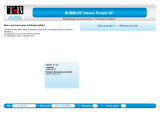
Table of contents
1 Product description ....................................................................................................................................... 1
2 Getting to know your computer ...................................................................................................................... 5
Locating hardware ................................................................................................................................................. 5
Locating software .................................................................................................................................................. 5
Display ................................................................................................................................................................... 6
Buttons ................................................................................................................................................................... 7
Keys ........................................................................................................................................................................ 8
Lights ..................................................................................................................................................................... 9
TouchPad ............................................................................................................................................................. 10
Left side ............................................................................................................................................................... 11
Right side ............................................................................................................................................................. 12
Bottom ................................................................................................................................................................. 13
3 Illustrated parts catalog .............................................................................................................................. 14
Locating the serial number, model number, product number, and warranty information ............................... 14
Computer major components ............................................................................................................................. 15
Display assembly subcomponents ..................................................................................................................... 21
Miscellaneous parts ............................................................................................................................................. 22
4 Removal and replacement preliminary requirements ..................................................................................... 25
Tools required ...................................................................................................................................................... 25
Service considerations ........................................................................................................................................ 25
Plastic parts ....................................................................................................................................... 25
Cables and connectors ...................................................................................................................... 25
Drive handling ................................................................................................................................... 26
Grounding guidelines ........................................................................................................................................... 27
Electrostatic discharge damage ....................................................................................................... 27
Packaging and transporting guidelines ......................................................................... 28
Workstation guidelines ................................................................................ 28
5 Removal and replacement procedures ........................................................................................................... 30
Component replacement procedures ................................................................................................................. 30
Keyboard/top cover .......................................................................................................................... 30
TouchPad board ................................................................................................................................ 35
Power button board .......................................................................................................................... 36
v





















